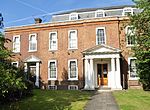123 Mortlake High Street
1700s establishments in EnglandCity and town halls in LondonGovernment buildings completed in 1720Grade II* listed buildings in the London Borough of Richmond upon ThamesGrade II* listed houses in London ... and 5 more
Houses completed in the 18th centuryJ. M. W. TurnerMortlake, LondonPages containing London Gazette template with parameter supp set to yUse British English from April 2022

123 Mortlake High Street, also known as The Limes or Limes House and previously referred to as Mortlake Terrace, is a Grade II* listed 18th-century property on Mortlake High Street in Mortlake in the London Borough of Richmond upon Thames. The building is now used as commercial office space. It was originally a private house and in the 20th century it functioned as the local town hall. It is featured in two paintings by J. M. W. Turner.
Excerpt from the Wikipedia article 123 Mortlake High Street (License: CC BY-SA 3.0, Authors, Images).123 Mortlake High Street
Mortlake High Street, London Mortlake (London Borough of Richmond upon Thames)
Geographical coordinates (GPS) Address External links Nearby Places Show on map
Geographical coordinates (GPS)
| Latitude | Longitude |
|---|---|
| N 51.4704 ° | E -0.2574 ° |
Address
Mortlake High Street 123
SW14 8SN London, Mortlake (London Borough of Richmond upon Thames)
England, United Kingdom
Open on Google Maps







